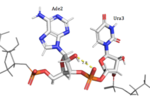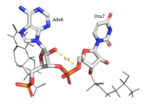User:Clayton Moore/Sandbox 1
From Proteopedia
(Difference between revisions)
| Line 2: | Line 2: | ||
== Introduction == | == Introduction == | ||
| - | Hrp1 is a heterogeneous ribonuclear protein of [https://en.wikipedia.org/wiki/Saccharomyces_cerevisiae Saccharomyces cerevisiae], baker’s yeast. Hrp1 is an essential component of 3’ [https://en.wikipedia.org/wiki/Post-transcriptional_modification pre-mRNA processing] and contributes to the preparatory cleavage required for polyadenylation. The gene expressed as Hrp1, HRP1, was first isolated by Henry, et al.<ref> Henry, Michael, et al. “Potential RNA Binding Proteins in Saccharomyces Cerevisiae Identified as Suppressors of Temperature-Sensitive Mutations inNPL3.” Genetics, vol. 142, Jan. 1996, pp. 103–115. </ref> and was later attributed to the Hrp1 protein by Kessler, et al.<ref> Kessler, Marco M, et al. “Purification of the Saccharomyces Cerevisiae Cleavage/Polyadenylation Factor I.” Journal of Biological Chemistry, vol. 271, no. 43, 25 Oct. 1996, pp. 27167–27175. </ref> Hrp1 also participates in the regulation of the 3’ end. | + | Hrp1 is a heterogeneous ribonuclear protein of [https://en.wikipedia.org/wiki/Saccharomyces_cerevisiae Saccharomyces cerevisiae], baker’s yeast. Hrp1 is an essential component of 3’ [https://en.wikipedia.org/wiki/Post-transcriptional_modification pre-mRNA processing] and contributes to the preparatory cleavage required for polyadenylation. The gene expressed as Hrp1, HRP1, was first isolated by Henry, et al.<ref> Henry, Michael, et al. “Potential RNA Binding Proteins in Saccharomyces Cerevisiae Identified as Suppressors of Temperature-Sensitive Mutations inNPL3.” Genetics, vol. 142, Jan. 1996, pp. 103–115. </ref> and was later attributed to the Hrp1 protein by Kessler, et al.<ref name="Kessler 1996"> Kessler, Marco M, et al. “Purification of the Saccharomyces Cerevisiae Cleavage/Polyadenylation Factor I.” Journal of Biological Chemistry, vol. 271, no. 43, 25 Oct. 1996, pp. 27167–27175. </ref> Hrp1 also participates in the regulation of the 3’ end. |
<StructureSection load='2cjk' size='400' side='right' caption='(PDB entry [[2cjk]])' scene=''> | <StructureSection load='2cjk' size='400' side='right' caption='(PDB entry [[2cjk]])' scene=''> | ||
| Line 10: | Line 10: | ||
=== Polyadenylation Complex === | === Polyadenylation Complex === | ||
| - | Hrp1 is a member of yeast mRNA cleavage factor 1 (CF1), which, along with the cleavage stimulatory factor (CstF), processes the 3’ end, most notably through polyadenylation. Though crucial in eukaryotic pre-mRNA processing, polyadenylation is especially important in yeast, where intron splicing is far less frequent than in higher eukaryotes.<ref> Guisbert, K. Kim. “Functional Specificity of Shuttling HnRNPs Revealed by Genome-Wide Analysis of Their RNA Binding Profiles.” RNA, vol. 11, no. 4, Jan. 2005, pp. 383–393., doi:10.1261/rna.7234205. </ref> CF1 binds mRNA upstream of the cleavage site<ref | + | Hrp1 is a member of yeast mRNA cleavage factor 1 (CF1), which, along with the cleavage stimulatory factor (CstF), processes the 3’ end, most notably through polyadenylation. Though crucial in eukaryotic pre-mRNA processing, polyadenylation is especially important in yeast, where intron splicing is far less frequent than in higher eukaryotes.<ref name="Guisbert 2005"> Guisbert, K. Kim. “Functional Specificity of Shuttling HnRNPs Revealed by Genome-Wide Analysis of Their RNA Binding Profiles.” RNA, vol. 11, no. 4, Jan. 2005, pp. 383–393., doi:10.1261/rna.7234205. </ref> CF1 binds mRNA upstream of the cleavage site<ref name="Kessler 1996" /> and is divided into two components, CF1a and b, the former of which contains Rna14, Rna15, Clp1 and Pfc11.<ref name="Minvielle-Sebastia 1998"> Minvielle-Sebastia, L. “Control of Cleavage Site Selection during MRNA 3 End Formation by a Yeast HnRNP.” The EMBO Journal, vol. 17, no. 24, 1998, pp. 7454–7468., doi:10.1093/emboj/17.24.7454. </ref> Hrp1 is the sole polypeptide of cleavage factor 1b (CF1b).<ref name="Kessler 1997"> Kessler, M. M., et al. “Hrp1, a Sequence-Specific RNA-Binding Protein That Shuttles between the Nucleus and the Cytoplasm, Is Required for MRNA 3-End Formation in Yeast.” Genes & Development, vol. 11, no. 19, Jan. 1997, pp. 2545–2556., doi:10.1101/gad.11.19.2545. </ref> Hrp1 interacts with the CF1a proteins Rna14 and Rna15 in an inverted U-like structure in the presence of mRNA.<ref name="Barnwal 2012"> Barnwal, R. P., et al. “Structural and Biochemical Analysis of the Assembly and Function of the Yeast Pre-MRNA 3 End Processing Complex CF I.” Proceedings of the National Academy of Sciences, vol. 109, no. 52, Oct. 2012, pp. 21342–21347., doi:10.1073/pnas.1214102110.</ref> Rna15 interacts with both RNA recognition motifs (RRMs) of Hrp15<ref name="Barnwal 2012" />, while Rna14 contacts Hrp1 in such a way that maximizes the distance between the negative domains of each protein.<ref> Leeper, Thomas C., et al. “Novel Protein–Protein Contacts Facilitate MRNA 3′-Processing Signal Recognition by Rna15 and Hrp1.” Journal of Molecular Biology, vol. 401, no. 3, 2010, pp. 334–349., doi:10.1016/j.jmb.2010.06.032. </ref> |
=== Specificity and Location=== | === Specificity and Location=== | ||
| - | Yeast hnRNPs, including Hrp1, are specific to certain mRNA strands. Hrp1 is specific to an mRNA efficiency element consisting of alternating UA sequencing<ref | + | Yeast hnRNPs, including Hrp1, are specific to certain mRNA strands. Hrp1 is specific to an mRNA efficiency element consisting of alternating UA sequencing<ref name="Guisbert 2005" /> approximately seven nucleotides in length.<ref> Chen, S. “A Specific RNA-Protein Interaction at Yeast Polyadenylation Efficiency Elements.” Nucleic Acids Research, vol. 26, no. 21, Jan. 1998, pp. 4965–4974., doi:10.1093/nar/26.21.4965. </ref> This sequence specificity, among other observational data, has given credence to the notion, first proposed by Minvielle-Sebastia, et al., that Hrp1 is not totally essential to the 3’ processing of every mRNA.<ref name="Minvielle-Sebastia 1998" /> This notion is further supported by the ability of yeast cells to survive hyperosmotic stress-induced extranuclear export of Hrp1.<ref name="Henry 2003"> Henry, M. F. “The Yeast HnRNP-like Protein Hrp1/Nab4 Accumulates in the Cytoplasm after Hyperosmotic Stress: A Novel Fps1-Dependent Response.” Molecular Biology of the Cell, vol. 14, no. 9, Nov. 2003, pp. 3929–3941., doi:10.1091/mbc.e03-01-0854. </ref> |
| - | Hrp1 participates in mRNA processing within the nucleus, but it may be found endo- or exonuclearly.<ref | + | Hrp1 participates in mRNA processing within the nucleus, but it may be found endo- or exonuclearly.<ref name="Henry 2003" /><ref name="Kessler 1997" /> A nuclear localization signal (NLS) at the C-terminal end of Hrp1 is essential to its recognition by the nuclear transportin receptor Kap104. The receptor and NLS are orthologous to human karyopherin B2 and hnRNP A1.<ref> Lange, Allison, et al. “A PY-NLS Nuclear Targeting Signal Is Required for Nuclear Localization and Function of TheSaccharomyces CerevisiaemRNA-Binding Protein Hrp1.” Journal of Biological Chemistry, vol. 283, no. 19, 2008, pp. 12926–12934., doi:10.1074/jbc.m800898200. </ref> |
=== Regulatory Function === | === Regulatory Function === | ||
Revision as of 17:43, 6 April 2018
HRP1 found in Saccharomyces cerevisiae
Introduction
Hrp1 is a heterogeneous ribonuclear protein of Saccharomyces cerevisiae, baker’s yeast. Hrp1 is an essential component of 3’ pre-mRNA processing and contributes to the preparatory cleavage required for polyadenylation. The gene expressed as Hrp1, HRP1, was first isolated by Henry, et al.[1] and was later attributed to the Hrp1 protein by Kessler, et al.[2] Hrp1 also participates in the regulation of the 3’ end.
| |||||||||||




